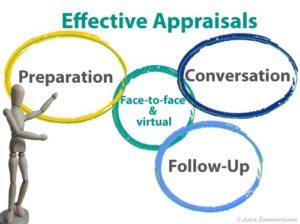How my preparation made annual appraisals very productive and constructive
In last week’s part I, I shared the general structure and an overview of what I consider an effective and positive appraisal process. If you have missed that, here is the link to catch up.
This week, in part II, I focus on an aspect which, in my experience, a lot of managers don’t pay enough attention to: the preparation phase.
The foundation of success: your preparation
 I consider three elements as very important in the preparation phase which I am going to describe in the following.
I consider three elements as very important in the preparation phase which I am going to describe in the following.
Create a broader view:
In order to make your assessment as broad-based as possible invite your direct reports to nominate people he/she has worked with throughout the year and who are able to give feedback about his/her performance. When I did it that way I always checked the list and sometimes added or removed people. Reason for this is that I encountered direct reports who nominated all their friends and left out all the people they struggled collaborating with.
Ask the nominated persons for feedback with the following principle: any evaluation they give on the performance has to be supported by facts and examples. Check with the people involved whether they want to keep confidentiality / anonymity or whether it is okay for them to be named when you talk about their feedback elements.
Create your own perspective:
Review performance of the direct reports based on all your feedback conversations you had throughout the year which you have ideally documented as outlined in part I of this blog series. If you have formal goals agreed with your direct reports review these and their achievement levels related to what you agreed with them at the beginning of the year.
Invite your direct reports to make his/her own assessment of the past year. Again make clear that the principle is that everything has to be fact-based /supported by examples. Ensure that your direct reports understand your standards for their performance assessment. If you miss this part of clarification you may end up in prolonged arguments about the level of their performance.
Compile an informal 360°-feedback perspective:
Review all feedback input you have received for your direct report and combine it with your own review into a summary. Make sure you have sufficient examples and facts available. Based on my experience, I would try to have at least two or three examples for each point of criticism you have about their performance.
Specific consideration for remote leaders:
As any virtual communication setting requires excellent time management to make it effective virtual leaders should consider the following when planning the appraisal conversation.
Consider what you must do online and what you and your direct reports could do off-line in order to make the best use of the time available.
When briefing your direct report about the process put even more emphasis on make the points of preparation and responsibility crystal clear.
It goes without saying that other cultures may be sensitive to collecting feedback in the above described manner.
Summary: Key tips for your preparation
1) Communicate your process to your direct reports so they know what to expect.
2) Collect feedback from people who work with your direct reports.
3) Review their year from your own perspective.
4) Compile a 360°- feedback perspective with sufficient facts and examples.
In part III I will outline some key aspects of the most effective way of conducting a feedback/appraisal conversation either in a face-to-face or virtual setting. It will be published next week.
So, if you’re interested in a more in-depth conversation about your particular challenge, please .
Or feel free to share your thoughts in the comments section below.
Thank you very much for your interest.



